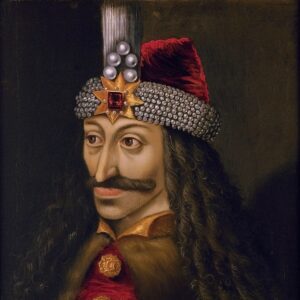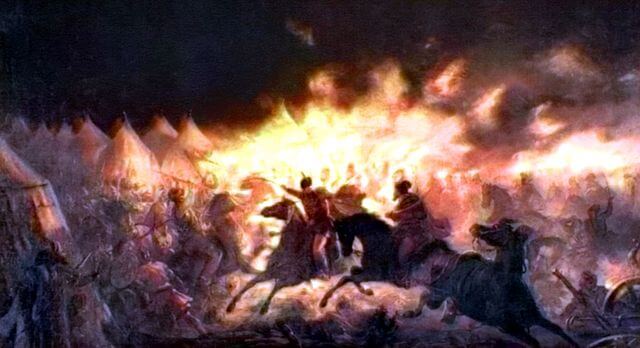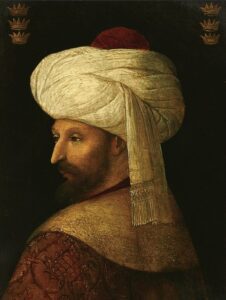How did Vlad the Impaler die? The death of the infamous Wallachia ruler is one of the great enigmas in history that still puzzles many experts and ordinary people.
Vlad the Impaler’s death, like his rule and life, is surrounded by mystery and controversy.
There are many historical theories about the death of Vlad the Impaler, one of the most iconic rulers of the Middle Ages.
In this article, we are going to present you all the scenarios surrounding the death of Vlad the Impaler, based on historical sources, and try to find out which one is the most plausible.
There are 4 major scenarios about the death of the mighty Vlad the Impaler, each more or less credible than the other, depending on the historical sources of the time.
I. Introduction: Who was Vlad the Impaler?

Vlad the Impaler was one of the most famous Romanian voivodes. His fame went beyond the borders of the Principality of Wallachia during his lifetime. His life and achievements are still considered today to be at the border between reality and legend.
Vlad the Impaler(Romanian: Vlad Ţepeş) was also the most illustrious victim of an organized defamation campaign, being described in chronicles and stories of German or Slavic origins as a bloodthirsty tyrant, cannibal, and murderer of innocent people.
At the same time, Vlad the Impaler remains in the collective memory as a symbol of the anti-Ottoman struggle and the desire for freedom, a tragic character. Vlad the Impaler’s reign and attitude towards injustice and violation of the law has been repeatedly invoked as a benchmark for the necessity of an Iron fist regime, especially in times of hardship.
II. Historical context.

In 1462, the second reign of Vlad the Impaler suddenly ends.
Although victorious in a battle against the Ottomans, he is forced to seek refuge in Transylvania in search of allies. The Ottomans installed his brother, Radu cel Frumos as the new ruler of Wallachia.
At the same time, many influential boyars sided with the pretender chosen by the Turks, wanting to keep their positions and hoping for a quick end to the bloody conflict.
On the other hand, Vlad the Impaler hoped to obtain military support from the King of Hungary, Matthias Corvinus, in order to regain his throne. The enemies of the voivode of Muntenia, however, wrote a compromising letter.
More precisely, through this letter, Vlad the Impaler’s opponents wanted to create the impression that the voivode of Muntenia would like to conclude a separate peace with the Ottomans and together raid Transylvania.
The letter ended up in the hands of the King of Hungary, and the fate of Vlad the Impaler was sealed. Not only did he not offer military aid to the voivode of Muntenia, but he also set a trap for him.
More precisely, Matthias Corvinus ordered the arrest of Vlad the Impaler. The voivode of Muntenia was arrested and imprisoned for 12 years in the fortress of Visegrad.
In 1474, Vlad the Impaler was released and remained in the service of the King of Hungary. For a year, he fought on behalf of the Hungarian crown in the Balkans, and in 1476 only, after a failed attempt, he was supported again to take the throne of Wallachia.
This time the one who supported Vlad the Impaler, was the voivode of Moldova, Stephen the Great.
Stephen the Great was launching a new anti-Ottoman and anti-Wallachian campaign. And this in the conditions in which his protégé Laiota Basarab, placed by Stephen the Great on the throne of Wallachia, had sided with the Ottomans.
The armies of Stephen the Great enter Wallachia, quickly beat the Muntenians, but also the Ottoman contingents that came to their aid, and installed Vlad the Impaler as voivode.
Moreover, Stephen the Great also offers Vlad the Impaler a guard of 200 Moldovan spearmen. It was to be the shortest reign of Vlad the Impaler shortest. The last reign of the famous Wallachian ruler only lasted for a few months.
III. Scenario 1: Vlad the Impaler was eliminated in an ambush
According to the ruler of Moldavia, Stephen the Great, who was also Vlad’s cousin; Laiota Basarab quickly returned with Ottoman support to regain the lost throne from Vlad the Impaler.
The Wallachian ruler fought valiantly against the Ottoman forces, somewhere between the modern-day Romanian towns of Giurgiu and Bucharest.
According to the Moldovian ruler, the small force of 200 soldiers left to defend Vlad was ambushed and only 10 soldiers manage to survive.
Unfortunately, Vlad the Impaler lost his life during this ambush.
This historical scenario is the most credible because it is presented by Stephen the Great, who heard about the chain of events from those 10 surviving soldiers, who most probably witnessed the entire situation.
IV. Scenario 2: Vlad the Impaler was assassinated by the boyars
The exact location and context of the assassination of Vlad the Impaler are not known in history, there are very few historical sources about this event.
According to the Moldavian ruler, Stephen the Great, Laiota Basarab, the deposed ruler of Wallachia returned with Ottoman support to reclaim his throne.
Vlad the Impaler intercepted the combined armies of Laiota and the Ottomans, and according to the Moldovian ruler, he might have won the skirmish.
According to this theory, Vlad the Impaler after winning the battle was eliminated by a paid assassin, who was hired by a faction of disloyal boyars.
This theory is plausible because though Vlad the Impaler reclaimed his throne, there was a powerful faction in Wallachia who strongly opposed him and his anti-Ottoman policies.
Hearing the news of the arrival of Laiota Basarab entering the country, the boyars most probably decided that this was the perfect moment to strike.
According to the medieval chronicler Mihail Bocignoli, Vlad was not assassinated by the boyars during a battle.
Instead of being ambushed on the battlefield, Vlad was eliminated by the boyars during a State meeting.
During this meeting, the anti-Vlad faction demanded that Vlad the Impaler should make peace with the Ottoman Empire and resume the payment of the tribute to them.
As you may anticipate, Vlad declared that as long as he would be alive, Wallachia would not bow to the power of the Ottoman Empire.
After a heating debate, the boyars demanded that Wallachia should surrender to the Ottomans.
Of course Vlad the Impaler strongly opposed the idea.
Left without any option, the boyars assassinated Vlad the Impaler during this meeting.
V. Scenario 3: assassinated by the Ottomans on the battlefield

Another version of the chain of events that led to the assassination of Vlad the Impaler is that the Wallachian ruler was actually killed on the battlefield by either the Ottomans or by the soldiers loyal to his enemy, Laiota Basarab.
According to this version of the story, which is presented again by Stephen the Great, the Wallachian ruler was intentionally abandoned on the battlefield.
Alongside Vlad the Impaler, only 200 Moldavian soldiers decided to fight till the end, and according to Stephen the Great, only 10 survived the battle.
After this skirmish, Vlad was captured by Laiota or the Ottomans and killed.
The head of the voivode of Muntenia was sent to the Turks, and then Sultan Mehmed II ordered it to be put on display on a pike.
According to another story, by an Austrian chronicler, Vlad the Impaler was allegedly assassinated by a Turk. He benefited from the help of the Wallachian boyars, who did not like Vlad the Impaler. The Turk was disguised as a servant, and when the ruler was left alone, the assassin stabbed him and cut off his head.
VI. Scenario 4: disguised and killed in error by his own soldiers
According to the medieval chronicler, Eufrosin of Agapia, Vlad the Impaler could’ve been assassinated by mistake on the battlefield, by his own soldiers.
According to the medieval historian, Vlad the Impaler was victorious against the armies of both Laiota Basarab and against the Ottomans and wanting to participate in the battle, he disguised himself as an Ottoman soldier.
His loyal troops, not knowing about this disguise, mistaken Vlad for an ordinary Ottoman soldier.
“Dracula’s army began to cut them mercilessly and drove them away. The devil of joy went up a hill to see how he was cutting tricks. He thus broke away from the army of those close to him and disguised himself in Turkish. His relatives considered him Turkish. And one struck him with his spear”
Before being killed by his own soldiers, Vlad manages to kill 5 of his own troops before succumbing to his wounds.
This historical theory is the least plausible because it is not the first time when Vlad used a clever disguise to attempt to gain an easy victory or deceive his enemies.
And the perfect example, in this case, is the famous Night Attack, when Vlad the Impaler, disguised as an Ottoman Jannisariy, nearly assassinated Sultan Mehmed II.
Even if this daring move has failed, Vlad manages to successfully escape the Ottoman camp during the chaos.
It is improbable that Vlad would’ve used this trick again without taking some safety measures or without properly calculating the risks.
VII. Most plausible scenario
Whatever the real chain of events that led to the demise of Vlad the Impaler was, we must all agree with an important fact.
During his 3 separate reigns over Wallachia, Vlad made a lot of enemies, both internally and externally(boyars, Ottoman Empire, the merchants from Brasov…).
Because Vlad the Impaler had so many enemies, the scenario of his demise as a consequence of a well-planned conspiracy cannot be excluded.
Most probably, the boyars or the Ottomans, or why not both, had planned the conspiracy so well, that the assassination of Vlad the Impaler might have looked like an accident.
Given all presented historical sources, most likely Vlad the Impaler meet his end on the battlefield. What we cannot tell for sure is if the was killed on the battlefield by a paid assassin, or during the heavy fighting.
The scenario, of either the Ottomans or the boyars deciding to strike against him exactly on the battlefield, cannot be excluded, but given the lack of historical sources, we cannot tell anything for sure about the existence of this plot.
With Vlad out of the picture, it was a win-win for everyone, the boyars retained their privileges while the Ottomans regained their influence over Wallachia.
VIII. Exact location of Vlad the Impaler’s tomb?
The place where Vlad the Impaler was buried is also a mystery. Initially, it was believed that he was buried in Snagov. According to research done by a Romanian historian, Constantin Rezachevici, Vlad the Impaler would have been buried at the Comana monastery, near Bucharest.
Archeological examinations have shown that the “tomb” of Vlad the Impaler at the Snagov Monastery actually contains only a few Neolithic horse bones and by no means the actual remains of the feared Wallachian ruler.
There is also an unlikely hypothesis, according to which the tomb of the Wallachian ruler would be in a church in Naples, since after the battle of 1476 Vlad the Impaler somehow manages to survive and is taken prisoner, then ransomed by one of his daughters, who was in Italy and would have died here, being buried in a church in Naples.
Even if we do not for sure the exact circumstances of Vlad the Impaler’s death and the exact location of his tomb, one thing is certain, that he was one of the bravest medieval rulers who fought valiantly against the Ottoman danger, and for his country.
Sources:
- Radu Stefan Ciobanu, Pe urmele lui Vlad Tepes, Bucuresti, 1979
2. Captivating History: Vlad the Impaler, A Captivating Guide to How Vlad III Dracula Became One of the Most Crucial Rulers of Wallachia and His Impact on the History of Romania
3. Hourly History, Vlad the Impaler: A Life From Beginning to End (Medieval History)

Pingback: 70 facts about Vlad the Impaler you don't know - HistoryForce